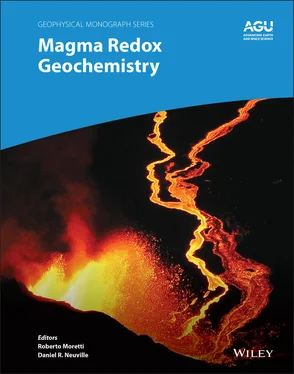Magma Redox Geochemistry
Здесь есть возможность читать онлайн «Magma Redox Geochemistry» — ознакомительный отрывок электронной книги совершенно бесплатно, а после прочтения отрывка купить полную версию. В некоторых случаях можно слушать аудио, скачать через торрент в формате fb2 и присутствует краткое содержание. Жанр: unrecognised, на английском языке. Описание произведения, (предисловие) а так же отзывы посетителей доступны на портале библиотеки ЛибКат.
- Название:Magma Redox Geochemistry
- Автор:
- Жанр:
- Год:неизвестен
- ISBN:нет данных
- Рейтинг книги:5 / 5. Голосов: 1
-
Избранное:Добавить в избранное
- Отзывы:
-
Ваша оценка:
- 100
- 1
- 2
- 3
- 4
- 5
Magma Redox Geochemistry: краткое содержание, описание и аннотация
Предлагаем к чтению аннотацию, описание, краткое содержание или предисловие (зависит от того, что написал сам автор книги «Magma Redox Geochemistry»). Если вы не нашли необходимую информацию о книге — напишите в комментариях, мы постараемся отыскать её.
Magma Redox Geochemistry
Volume highlights include: Magma Redox Geochemistry
The American Geophysical Union promotes discovery in Earth and space science for the benefit of humanity. Its publications disseminate scientific knowledge and provide resources for researchers, students, and professionals.
Magma Redox Geochemistry — читать онлайн ознакомительный отрывок
Ниже представлен текст книги, разбитый по страницам. Система сохранения места последней прочитанной страницы, позволяет с удобством читать онлайн бесплатно книгу «Magma Redox Geochemistry», без необходимости каждый раз заново искать на чём Вы остановились. Поставьте закладку, и сможете в любой момент перейти на страницу, на которой закончили чтение.
Интервал:
Закладка:
The activity of magnetite in spinel is itself highly dependent on accurate determination of the ferric iron content within the spinel phase. The studies included in this compilation determine ferric iron content in spinel using either Mössbauer spectroscopy or electron probe microanalysis (EPMA). In the case of EPMA, ferric iron content cannot be determined directly and is instead calculated using stoichiometric constraints. The preferred method of determining ferric iron content in this manner involves correcting the values based on a set of calibration spinels, with ferric iron contents independently determined by Mössbauer, run at the beginning and end of each EPMA session (e.g., Wood & Virgo, 1989; Davis et al., 2017). For peridotites from ridges, arcs, and forearcs compiled in this study, we have only included data in which the Fe 3+/∑Fe ratio of spinel was determined via Mössbauer or corrected EPMA. In the case of xenoliths from OIB localities, we have chosen to additionally include a number of studies in which this correction was not applied, due to the paucity of measurements using spinel standards for correction. Uncertainty in f O 2increases when uncorrected EPMA analyses of spinels are used to calculate f O 2, but the degree to which that uncertainty increases is dependent on the Fe 3+/∑Fe ratio of the spinel. Uncertainty in f O 2is greater for spinels with lower Fe 3+/∑Fe ratios and lesser for spinels with higher Fe 3+/∑Fe ratios (Ballhaus et al. 1991; Davis et al. 2017). For example, f O 2calculated from corrected EPMA analyses of spinels with Fe 3+/∑Fe = 0.10 has an f O 2uncertainty of about +0.3/‐0.4 log units, whereas the uncertainty roughly doubles for uncorrected spinel analyses. At Fe 3+/∑Fe > 0.35, f O 2uncertainty is only about 0.1 log units for corrected EPMA analyses, and doubles to about 0.2 log units when the analyses are uncorrected. Therefore, the potential effects of including uncorrected analyses on the distribution of f O 2recorded by peridotites from an oxidized setting is likely to be small.
The calculation of oxygen fugacity also depends highly on assumptions about the temperature and pressure of equilibration. In order to maintain consistency between datasets, we calculate the f O 2values of all mantle lithologies at 0.6 GPa and the temperature recorded by spinel‐olivine thermometry. Justification for this choice can be found in Birner et al. (2017) for forearc/arc peridotites and Birner et al. (2018) for mid‐ocean ridge peridotites. Although we choose these values to maintain consistency, there is no rigorous method available to estimate pressure recorded by spinel peridotite xenoliths and no thermal model that can be easily applied to plume‐influenced lithosphere that would allow recorded temperature to be related to a depth along a geotherm. OIB xenoliths could potentially have been exhumed from any depth within the spinel stability field. Assuming a maximum pressure of 2.5 GPa, the choice to calculate f O 2at 0.6 GPa may lead to an overestimation of f O 2relative to QFM by as much as 0.6 to 0.8 log units. This difference in f O 2relative to QFM is owing to the differences in ΔV of the QFM reaction and the reaction underlying the spinel oxybarometer (fayalite‐ferrosilite‐magnetite).
Modeling in DCompress.We modeled the change in magmatic f O 2with progressive degassing of a C‐O‐H‐S vapor using the gas‐melt equilibrium model of Burgisser et al. (2015). This thermodynamic model computes C, H, O, and S concentrations and speciation in coexisting gas and silicate melt as functions of pressure, temperature, melt composition, and f O 2, based on experimental calibrations of melt solubility and homogeneous equilibrium in the gas phase for H2, H2O, CO, CO 2, SO 2, H2S, and S2 species. The melt does not change in major element composition during degassing (i.e., there is no crystallization) and it is not permitted to precipitate separate sulfide or carbon phases.
We followed the methodology of Brounce et al. (2017) to compute the degassing trajectories, except that we used the DCompress default solubility models for C‐O‐H‐S species. We used the default basalt composition and non‐temperature dependent solubility relationships of H2, H2O, CO 2, H2S, and SO 2. We also executed model runs wherein we set the solubility of H2 in the silicate melt to zero in order to demonstrate how uncertainty in the speciation of H‐species in silicate melts (e.g., finite solubility [Hirschmann et al., 2012; Mysen et al., 2011] vs no solubility ([Newcombe et al., 2017]) propagates into uncertainty in degassing trajectories, particularly those at relatively low f O 2. Among these simulations, only the scenario of an arc magma decompressing at QFM= 0 (i.e., H2O‐rich magma in equilibrium with a gas phase containing non‐negligible amounts of H2) was sensitive to this assumption ( Fig. 3.5). All calculations are calculated as equilibrium (i.e., batch) isothermal decompression, at 1100 °C. The calculations intended to simulate MORB degassing were started at QFM and 1385 bar, with concentrations of volatiles similar to those calculated for globally representative primary MORB melts (Le Voyer et al., 2018) containing 0.2 wt.% H2O, 1100 ppm C O2, and 1425 ppm S. Increasing CO 2to several thousand ppm has no effect on the trajectories shown. The calculations intended to simulate OIB degassing were started at QFM +1.4 and 2115 bar, with concentrations of volatiles similar to those expected for undegassed Erebus melts (Mousallam et al., 2014) containing 1.5 wt% H 2O, 1710 ppm CO 2, and 2430 ppm S. The calculations intended to simulate arc degassing were started at QFM +1.5 and 2380 bar, with concentrations of volatiles similar to those observed in melt inclusions from Agrigan volcano, containing 4.5 wt.% H 2O, 800 ppm CO 2, and 2050 ppm S (e.g., Kelley & Cottrell, 2012). Melt chemistry (including f O 2) and gas phase compositions were calculated in 1 bar increments and stopped at 5 bars (total pressure).
REFERENCES
1 Allen, W., & Snow, R. (1955). The orthosilicate‐iron oxide portion of the system CaO‐“FeO”‐SiO2. Journal of the American Ceramic Society, 38(8), 264–272.
2 Anderson, A. T., & Wright, T. L. (1972). Phenocrysts and glass inclusions and their bearing on oxidation and mixing of basaltic magmas, Kilauea Volcano, Hawaii. American Mineralogist, 57(1–2), 188–216.
3 Andreani, M., Munoz, M., Marcaillou, C., & Delacour, A. (2013). u‐XANES study of iron redox state in serpentine during oceanic serpentinization. Lithos, 178, 70–83. doi: 10.1016/j.lithos.2013.04.008
4 Arce, J. L., Gardner, J. E., & Macias, J. L. (2013). Pre‐eruptive conditions of dacitic magma erupted during the 21.7 ka Plinian event at Nevado de Toluca volcano, Central Mexico. Journal of Volcanology and Geothermic Research, 249, 49–65. doi: 10.1016/j.jvolgeores.2012.09.012
5 Bacon, C. R., & Hirschmann, M. M. (1988). Mg/Mn Partitioning as a Test for Equilibrium between Coexisting Fe‐Ti Oxides. American Mineralogist, 73(1–2), 57–61.
6 Baggerman, T. D., & DeBari, S. M. (2011). The generation of a diverse suite of Late Pleistocene and Holocene basalt through dacite lavas from the northern Cascade arc at Mount Baker, Washington. Contributions to Mineralogy and Petrology, 161(1), 75–99. doi: 10.1007/s00410‐010‐0522‐2
7 Bali, E., Keppler, H., & Audetat, A. (2012). The mobility of W and Mo in subduction zone fluids and the Mo–W–Th–U systematics of island arc magmas. Earth and Planetary Science Letters, 351–352, 195–207. doi: 10.1016/j.epsl.2012.07.032
8 Ballhaus, C. (1993). Redox States of Lithospheric and Asthenospheric Upper‐Mantle, Contributions to Mineralogy and Petrology, 114(3), 331–348.
Читать дальшеИнтервал:
Закладка:
Похожие книги на «Magma Redox Geochemistry»
Представляем Вашему вниманию похожие книги на «Magma Redox Geochemistry» списком для выбора. Мы отобрали схожую по названию и смыслу литературу в надежде предоставить читателям больше вариантов отыскать новые, интересные, ещё непрочитанные произведения.
Обсуждение, отзывы о книге «Magma Redox Geochemistry» и просто собственные мнения читателей. Оставьте ваши комментарии, напишите, что Вы думаете о произведении, его смысле или главных героях. Укажите что конкретно понравилось, а что нет, и почему Вы так считаете.












